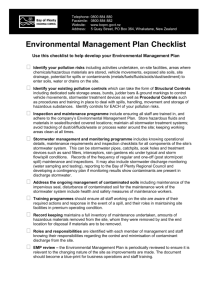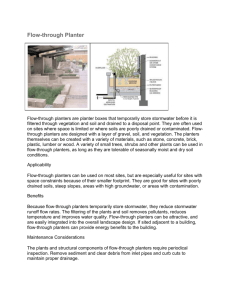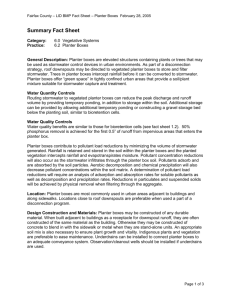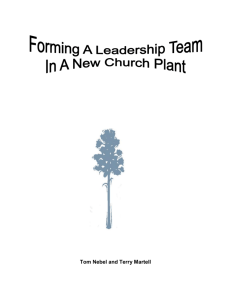Simplified Approach Design Criteria
advertisement
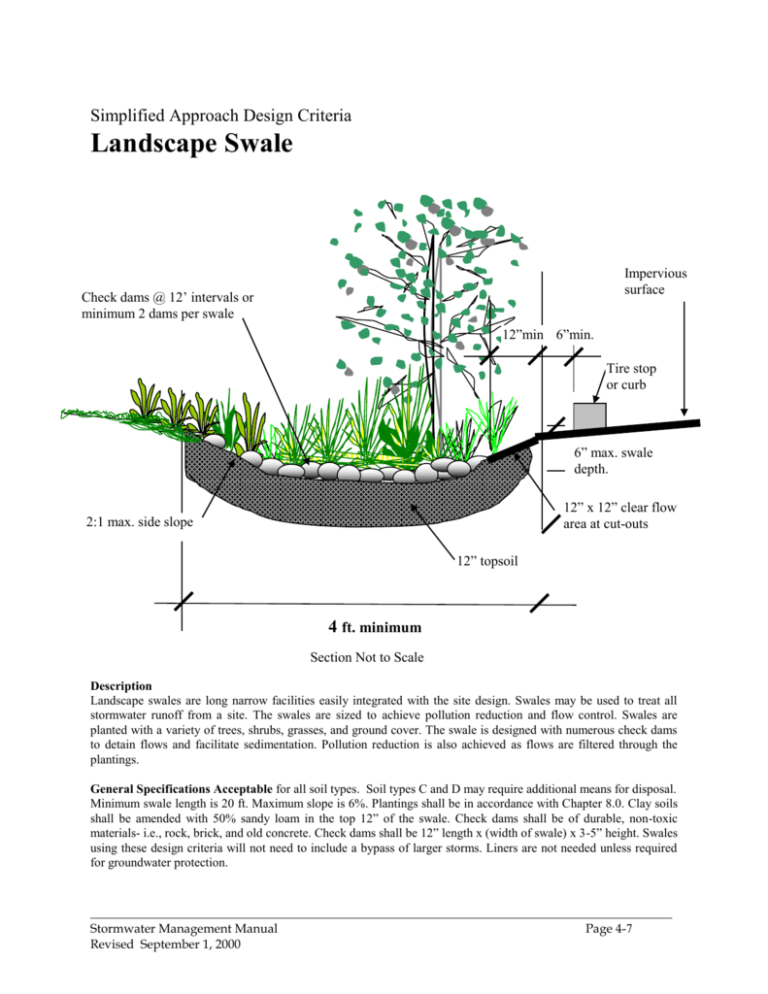
Simplified Approach Design Criteria Landscape Swale Impervious surface Check dams @ 12’ intervals or minimum 2 dams per swale 12”min 6”min. . Tire stop or curb 6” max. swale depth. 12” x 12” clear flow area at cut-outs 2:1 max. side slope 12” topsoil 4 ft. minimum minimum Section Not to Scale Description Landscape swales are long narrow facilities easily integrated with the site design. Swales may be used to treat all stormwater runoff from a site. The swales are sized to achieve pollution reduction and flow control. Swales are planted with a variety of trees, shrubs, grasses, and ground cover. The swale is designed with numerous check dams to detain flows and facilitate sedimentation. Pollution reduction is also achieved as flows are filtered through the plantings. General Specifications Acceptable for all soil types. Soil types C and D may require additional means for disposal. Minimum swale length is 20 ft. Maximum slope is 6%. Plantings shall be in accordance with Chapter 8.0. Clay soils shall be amended with 50% sandy loam in the top 12” of the swale. Check dams shall be of durable, non-toxic materials- i.e., rock, brick, and old concrete. Check dams shall be 12” length x (width of swale) x 3-5” height. Swales using these design criteria will not need to include a bypass of larger storms. Liners are not needed unless required for groundwater protection. ____________________________________________________________________________________________ Stormwater Management Manual Page 4-7 Revised September 1, 2000 Simplified Approach Design Criteria Vegetative Filter Flow spreader flow Check dams @ 5’ intervals Impervious area Inlet or conveyance swale 12” topsoil 10 ft. minimum Section Not to Scale Description Vegetative filters are gently sloped areas, with direction of stormwater flow conforming to the slope. Stormwater enters the filter as sheet flow from an impervious surface or is converted to sheet flow using a flow spreader. Flow control is achieved using the relatively large surface area and a generous proportion of check dams. Pollutants are removed through filtration and sedimentation. Filters can be planted with a variety of trees, shrubs, and ground covers, including grasses. General specifications (Acceptable soil types A, B, C, & D) Filters shall be a minimum of 20 ft. x 10 ft. Maximum slope is 10%. Plantings shall be in accordance with Chapter 8.0,. Check dams shall be of durable, non-toxic materials- i.e., rock, brick, and old concrete. Check dams shall be 12” length x (width of filter) x 3-5” height. Filters designed using these criteria will not need to include a bypass of larger storms. Runoff shall enter the buffer as predominately sheet flow. Check dams and flow spreaders are required. ____________________________________________________________________________________________ Stormwater Management Manual Page 4-8 Revised September 1, 2000 Simplified Approach Design Criteria Stormwater Planter AB Plantings Overflow option Reservoir-12” 12” Downspout Gravel/ Splash block 1212” 12”Sandy loam topsoil 12”” 18”Sandy loam topsoil 12” 18” Pea gravel 3/8” to 5/8”, Min. 24” wide Section Not to Scale Existing soil Description Planter AB is designed to allow runoff to filter through the planter soils (thus capturing pollutants) and then infiltrate into the native soils (flow control). The planter is sized to accept runoff and temporarily store the water in a reservoir on top of the soil. General specifications (Acceptable soil types A & B) There are numerous design variations. The planters shall be designed to allow captured runoff to drain out in 3-4 hours after a storm event. Plantings shall be in accordance with Chapter 8.0 and be appropriate for moist and seasonally dry conditions, and can include rushes, reeds, sedges, iris, dogwood, currants, and numerous other shrubs, trees, and herbs/grasses. Topsoil shall have infiltration rate of 2”/hr. Sand/gravel area may not be required if existing soil has at least 5”/hr. infiltration rate. The sand/gravel area width, depth and length are to be determined by a qualified professional. Minimum planter width is 30”; there is no minimum length or required shape. The structural elements of the planters shall be stone, concrete, brick, wood, or other durable material. Treated wood shall not leach out any toxic chemicals. Planters within 10 ft of structure must use Design Criteria for Stormwater Planter CD or request an exception through OPDR to the Building Code requirement that stormwater facilities must be less than 10 ft from the structure. ____________________________________________________________________________________________ Stormwater Management Manual Page 4-9 Revised September 1, 2000 Simplified Approach Design Criteria Stormwater Planter CD Building Plantings Downspout Use reverse bend trap Reservoir-12” 112” Gravel/ Splash block 18”Sandy loam topsoil 118” 12”Pea Gravel (3/8” to 5/8”) Perforated pipe Sub-grade or existing soil Pipe to main storm system (trap Section Not to Scale Waterproof building as needed Foundation drains as required Description Planter CD is designed with an impervious bottom or is placed on an impervious surface. Pollutant reduction is achieved as the water filters through the soil; flow control is obtained by storing the water in a reservoir above the soil. (Nominal infiltration can be allowed if soils and other geotechnical issues are addressed by a qualified professional.) This planter can be used adjacent to a building with OPDR approval. This planter could be included in setback if less than 30 inches in height (above finished grade) General specifications (Acceptable soil types C & D) There are numerous design variations allowed for these planters. The planters shall be designed to hold water for no more than 3-4 hours after an average storm event. Plantings shall be in accordance with Chapter 8.0 and be appropriate for moist and seasonally dry conditions, and can include rushes, reeds, sedges, iris, dogwood, currants, and numerous other shrubs, trees, and herbs/grasses. Minimum planter width is 18”; there is no minimum length or required shape. Topsoil shall have infiltration rate of 2”/hr. Sand/gravel shall have a minimum infiltration rate of 5”/hr. The structural elements of the planters shall be stone, concrete, brick, wood, or other durable material. Treated wood shall not leach out any toxic chemicals. Planter CD is contained and thus is not designed to drain into the ground near a building. Irrigation is optional, although plant viability shall be maintained. ____________________________________________________________________________________________ Stormwater Management Manual Page 4-10 Revised September 1, 2000 Simplified Approach Design Criteria Landscape Infiltration Max. 2:1 side slopes 12” topsoil Inflow 18” max. depth 5 ft. minimum Section Not to Scale Description Landscape infiltration areas can be integrated into the site design and required landscaping. The design can be formal or informal in character. The system works by holding runoff and allowing pollutants to settle as the water infiltrates. Flow and volume are also managed with these facilities. General specifications (Acceptable soil types A & B) These facilities are appropriate for soils with a minimum infiltration rate of 2 inches per hour. Facility storage depth may vary from 6- 18” maximum. Maximum side slopes are 2H: 1V. Minimum bottom width is 3 ft. Landscape may include a variety of trees, shrubs, grasses, and groundcover appropriate for periodic inundation. Plantings shall be in accordance with Chapter 8.0 requirements. Depending on Soil type & condition this facility may provide disposal as well as treatment. OPDR approval required for disposal method. ____________________________________________________________________________________________ Stormwater Management Manual Page 4-11 Revised September 1, 2000 Simplified Approach Design Criteria Sand Filter Building Downspout Overflow options (Reverse bend trap recommended) Reservoir - 12” Gravel/splash block Sand 30” min. Perforated pipe Waterproof building as needed Sub-grade or existing soil Pipe to main storm system Foundation drains as required Section Not to Scale Description There are two filter options. One is designed with an impervious bottom or is placed on an impervious surface. It can be used for NRCS soil types C and D. Some infiltration can be allowed if geotechnical issues are addressed by a qualified professional. The other option, for soils A and B, allows filtered water to infiltrate the ground. For both options, pollutant reduction is achieved as the water filters through the sand; flow control is obtained by storing the water in a reservoir above the sand. Filters may be constructed in-ground or above grade. General specifications (Acceptable soils types A, B, C, or D, with limitations) There are numerous design variations allowed for these filters. Filters shall drain within 2-3 hour after a storm event. Sand shall have a minimum infiltration rate of 5”/hr. The structural elements of the planters shall be stone, concrete, brick, wood, or other durable material. Treated wood shall not leach out any toxic chemicals. Where conditions allow (acceptable soil type and land use), the filter may be constructed without an impervious bottom. ____________________________________________________________________________________________ Stormwater Management Manual Page 4-12 Revised September 1, 2000




